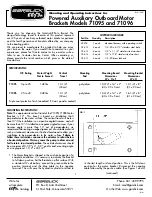
Fig. 44
Page Number - 24
continues to experience symptoms of a fuel delivery malfunction, it
could be caused by contaminated fuel, faulty fuel injector(s), or an
intermittent component malfunction such as a sticking pressure regu-
lator or loose electrical connection. Follow the vehicle manufacturer’s
recommended procedures for the inspection and repair of these com-
ponents.
If the FST test results indicate a fuel delivery system malfunction, and
the diagnostic chart clearly pinpoints the cause, follow the vehicle
manufacturer’s repair procedures to correct the malfunction. After
performing the repairs, re-test the fuel delivery system with the FST to
ensure it is operating normally.
If the FST test results are inconclusive as to whether there is a fuel
delivery system malfunction, or if a malfunction is evident but the
diagnostic chart does not clearly indicate the cause, additional testing
may be performed to provide more insight into the performance of the
system. Extended test procedures are outlined below, and provide a
more in-depth understanding of how the components of the fuel sys-
tem affect its performance.
Additional Testing and Diagnostics
To perform more in-depth diagnostics, consider the fuel delivery sys-
tem split into three zones as shown in figure 44. The initial test proce-
dures outlined above are performed in Zone 2 because the fuel pres-
sure and flow within this zone, most accurately represent the condi-
tions present in the fuel rail. Depending on the suspected component
malfunction, connecting the FST in either Zone 1 or Zone 3 and com-
paring the test results to those in Zone 2 can help pinpoint a malfunc-
tion.
Blocked Inline Fuel Filter
If the inline filter is clean, pressure and flow in Zones 1 and 2 should
be equal. A clogged filter will cause the pressure to increase in Zone 1
and the flow to decrease in Zone 2.
If the results of testing in Zone 2 indicate a blocked fuel filter, but are
not entirely conclusive, retest the fuel system with the FST connected
in Zone 1, preferably at the inlet of the fuel filter. If the idle pressure
and the peak flow in Zone 1 are higher than Zone 2, replace the inline
fuel filter and retest.
If the idle pressure and peak flow in Zone 1 remain the same as Zone
2, this would indicate a clogged inlet strainer/sock.
Clogged Inlet Strainer/Sock
The test results for pressure and flow of a clogged inlet strainer will
closely match those of a clogged inline filter. The peak pressure of a
clogged inlet strainer will be slightly lower than the peak pressure of a
clogged inline filter, and the current draw will also be lower.
A clogged inlet strainer can cause the fuel pump to cavitate because
it is starved for fuel. Cavitation will create rapid changes in fuel densi-
ty, causing the float in the FST flowmeter to bounce up and down. It
can also cause the needle on the pressure gauge to bounce. Also, as
the pump tries to pull gas through the clogged strainer, it creates a
pressure drop that may cause air bubbles to form and become visi-
ble.
These indications of a clogged inlet strainer may or may not be evi-
dent during testing. If the results are inconclusive, retest the fuel sys-
tem with the FST connected in Zone 1, preferably at the inlet of the
fuel filter.
If the idle pressure and peak flow in Zone 1 remain the same as Zone
2, this would indicate a clogged inlet strainer/sock. Replace the
strainer or the pump module, and retest.
Zone 1– Red
Zone 2 – Blue
Zone 3 - Yellow
















































